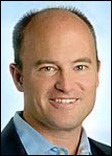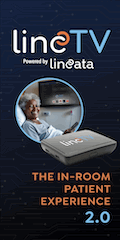HIStalk Interviews Joel French, CEO, SCI Solutions
Joel French is managing partner and CEO of SCI Solutions of Campbell, CA.

Tell me about yourself and why you joined SCI.
I’m an economist by training. I was an immature college kid. I went to school to play sports and chase girls and ended up learning about price and elasticity of demand a long time ago. I figured even a guy like me could do OK in healthcare. That was a long time ago.
I started in the physician business, back with a physician practice management company in the ‘80s. Learned that business a little bit and learned the health plan side and learned a little bit about finance.
Jeff Anderson has been my partner in this effort. Now, along with John Holton, we’re leading SCI Solutions, along with NEA and The Wicks Group. We saw a couple of things here that we believed were unique. One is that there’s this collision point happening right now, where the line of demarcation between the financial and the clinical is blurring, and we think it’ll soon be eradicated. Reimbursement is very much an issue of clinical appropriateness, and both reimbursement and clinical appropriateness have become a matter of compliance.
The unique role that SCI has is we capture and digitize a transaction at its very point of origin in the ambulatory setting. Years ago, you might recall that The Advisory Board did a study finding that 80% of the controllable costs in healthcare hinged on physician behavior. Do you refer, do you admit, are you going to do a surgery, and so forth. We believe there’s a growing opportunity to infuse that referral transaction, or that ordering or scheduling transaction, with clinical intelligence; deeper, broader medical necessity reviews; smarter eligibility; and ways of looking at what’s the best way to take care a patient that may have a chronic condition or a comorbid condition, and what patients are eligible for, perhaps an episodic hip replacement program that might be in effect in that community. That was of high interest to us.
We were looking for a strong culture. We were looking for a business that had scale and deep, wide client footprint. SCI clearly does, with 450-some hospitals and something like 30,000 physicians. We were looking for a Software as a Service business model, so that from a vantage point of a client implementing, the capability was fast, it was capital-efficient, and it wasn’t a burden on them because they’re burdened with everything else right now. I could go on, but that’ll give you a snapshot.
The company now has a broader senior team and new investment. What are you going to do with your new capabilities?
The main thing is we’re going to help our clients navigate the transition that’s sitting right in front of them like a storm right now, particularly reimbursement reform. I was with nine clients last week in California, and without exception, all of them are worried about the legislative and regulatory burdens, both those that are in place and those that are coming around the corner.
For the average hospital, as you know, 40% of their net revenue is Medicare-dependent, and they lose eight cents on the dollar. And maybe something like 15% is Medicaid-dependent, and they lose 12 cents on the dollar. I was with a few clients last week where their Medicare exposure was 70 and 75%, respectively, so they’re very worried about this.
The company has had a 97% client retention rate that it’s managed over the years. It’s done a really good job. I think our big focus is helping our clients unlock the value of the existing infrastructure that they’ve implemented, the SCI infrastructure, to bring some working capital and liquidity to their business. Because if you think about it, most of these guys are somewhere on the horizon of laying down tens if not hundreds of millions in funds to automate manual processes, or to replace departmental systems with enterprise architecture systems.
That may be the right thing to do. For a lot of them, it is. I think that some of them are beginning to be worried that there may be an absence of measurable, risk-adjusted return on that capital, but what they know is they’re going to get depreciation on their P&L. They know they’re going to be guaranteed software maintenance expense that’s higher, and a bunch of IT FTEs running around. Potentially, if they use debt, some interest on that debt.
At a time where you’re hiring physicians and your labor expense of net revenue has gone up and your reimbursement is going down, it doesn’t look very pretty on the horizon. Helping them unlock some working capital in their business and helping them be smart about how do they connect with patients in the community and non-employed physicians in the community — it’s a focus area for us and that’s been what the company has been known for.
Folks say the pendulum always swings back, and even though the emphasis is on clinical systems, it will come back to financial systems. Do you think that the timing is right to get in front of people that are locked into a project plan and have spent a lot of money to get a system, but knowing that at some point, especially with healthcare reform, they’ll have to look at their financial side?
No margin, no mission. I think the CFO job right now is arguably among the most important of any in a health system. I can’t imagine people that are – I guess I can, because I’ve met some — that aren’t thinking about what’s going to happen in the near future. Many of the leading prognosticators have talked about an acceleration of hospital bankruptcies. Folks that are going to have to seek merger partners on terms that aren’t commercially favorable to them because they haven’t gotten their cost at a level where they can break even on the patient mix with Medicare and Medicaid.
Somebody implementing a clinical system should be doing so for all the right reasons. You know, the surest path to long-term low cost is quality, like W. Edwards Deming said. I think he’s right, but there’s going to be a huge pivot away from simply automating stuff to generating business yield. I don’t see that right now. I see a bunch of organizations ramming in systems, ostensibly for incremental Meaningful Use reimbursement. Some of them are doing it really well. We’re going to find out.
As far as the plan to use the investment that you have, is it to build more product or to get the word out on the product that’s already available?
I think it’s to make sure that the current clients are realizing the full measure of value that they can. Our products in some respects are not like Microsoft Excel, where a typical client utilizes less than 50% of the capability. There’s an important question: how do we make sure that people are getting the value that they’ve already implemented?
Secondly, it’s to address those workflow adjacencies or business adjacencies that are literally right next to where our products are implemented, so that the physician referring a case or ordering a case can derive more benefit without us trying to take them very far afield from what they know and love about SCI.
I think the other thing is we’ve already built what you might think of as a pipeline of possible acquisition candidates that meet the fairly rigorous set of criteria in four quadrants that we look for. We’re well downstream with a handful of these now. We may or may not do anything there. It just depends on the timing and the terms and what’s best for the clients and the business and whoever our combination partner might be. But that non-organically growing business may be an option to us. We certainly have the access to capital. We also have the leadership team to grow a much larger business.
The two hottest areas that might have an impact on what you want to do would seem to be revenue cycle management and consulting services. Do those fit in to the kinds of things you’d contemplate as an acquisition?
No.There’s plenty of really good consulting firms in the market today and I’m not sure the market needs another one. I don’t see us trying to aggregate a bunch of billable FTEs.
The focus is really helping our clients to better orchestrate patient care transitions and access. You know, if you have 16 million more Medicaid enrollees coming into the system, somebody’s got to figure out, where do you treat these people and how do you treat these people? They’ve just been going to the emergency department for primary care in the past. How do you intelligently apportion the ability to educate and care for somebody across a community?
The second is helping these clients align and link their reimbursement with clinical appropriateness and regulatory compliance. That’s the business we’re in, and that’s what we’re focused on.
It’s an unrelated question more about your history, but from your background from Motion Computing, do you think the iPad made their job tougher?
I’d learned a lot at Motion from my colleagues there and from the clients. I guess in a way it did, but the iPad has catalyzed, it seems, a big market shift. Gartner Research said the tablet category was a million units worldwide way back in ’03, ’04. I don’t recall the data offhand, but I think Apple may do – gee, you might have the numbers handy – 70 million iPads? I mean, it’s a big number, whatever it is. It’s catalyzed this shift from clamshell-type laptops to devices that can be used while walking and standing, which was Motion’s vision all along.
The question for Motion is, can they continue to succeed in the professional industries where the companies that like healthcare, where you have a toxic 24/7 environment with biologicals everywhere — blood, urine, the stuff that gives rise to nosocomial infections — and having devices that are sealed, durable, cleanable that can run the mainstream applications. I think it’ll be interesting, because what I’ve seen about the iPad is that it appeals to the docs that can buy it for 600 bucks. If they can get their apps to run on it, maybe that’s good enough for them. Time will tell.
Also from your background, I’m curious, if you were advising an aspiring entrepreneur who wanted to do some sort of a startup in a healthcare IT, either a products or services firm, what areas would you say look most attractive right now for a fairly quick payback?
I’m not sure anything’s easy. I don’t have any silver bullet answers, I’m sorry, I wish I did. I think that I would just say find a basket of clients that you trust and go listen to them, and see if there are some endemic unresolved business problems that the current set of suppliers couldn’t or haven’t remedied that you could carve out some advantage and protect that advantage over time.
But I don’t know. In terms of the business prospects areas or technology areas, I don’t have any easy answers for an aspiring entrepreneur. It’s all difficult. Some guys just get lucky or strike it right.
You mentioned that there are plenty of good consulting companies out there. You have a background in that as well. Are you surprised that big companies keep buying healthcare IT consulting firms?
No. Let the cycle continue.
Is that always going to be the case, with the big fish swallowing the smaller ones and then spawning more small ones?
Well, I don’t know if I could use the word always and I wouldn’t use the word never. Back in the day when there was just Superior Consultant Holdings and also First Consulting as the boutique domain experts in the market, everybody else was either Accenture and E&Y and so forth. We were the mid-market. If there was a publicly traded scale player that wanted to buy en masse a small little company with 100 people, it wasn’t significant to their earnings. They couldn’t put enough resources to work to make the business meaningful.
I think that’s what we’re seeing here, where entrepreneurs build up expertise, they deliver some modicum of scale – maybe they’re at 100 million or 200-300 million — and they become attractive to a larger organization that needs to do a scale buy and needs earnings. I think what happened when Superior was sold, First Consulting Group was sold, and Healthlink was sold to IBM.
It created a market gap, where entrepreneurs could take a company of 15 people, 30 people and bring it up into the several hundred people range so that they were now that new mid-market. I think we’re seeing that. Parker Hinshaw has done that at maxIT. The guys at Vitalize have done that. There’s other firms growing as well, as you know. You know this market really well.
Give me some predictions about either healthcare IT or healthcare in general that would span five to 10 years, things you’re thinking that would be surprising to the average person who doesn’t pay as much as attention as I’m sure you must.
I’m not a popular guy for saying this a lot, but, I’m a truth-teller. I think that there will be a growing number of hospital executives that are removed from their roles as officers because they either didn’t astutely apportion scarce resource or they couldn’t manage the financial enterprise successfully. The organization is either looking for new leadership or they’re looking for somebody to blame, one of the two. I think that will be true of CEOs, CFOs, CIOs, and a number of others.
People don’t like to hear that, but I don’t know how you go spend $70 million and don’t have an answer for what you got for that. I’m not sure how that’s OK with an organization running a 1% operating margin, triple-B bond rating, an 8% to 11% allowance for bad debt, and a ton of interest payments in an era where reimbursement reform is getting very ugly. But that is one point of view I happen to have. The guys that are on some of the boards that I’m on are asking questions today that they wouldn’t have asked 10 years ago.
If we look down the road 10 years, based on your crystal ball, how do you think the IT market will look different from how it looks today?
I don’t have a crystal ball and I wish I could think 10 years out. I’ll try, but there are some really smart guys that paid to do that and do it well.
I think it’s fair to say that the data will be increasingly digital. We’ve seen that already. If you look at the HIMSS Analytics EMR Adoption Model – and I watch it every quarter – the pace of movement just in the last 18 months alone, it’s been very significant. The Meaningful Use catalyst has been effective, it seems. With digital data, you can do a lot more with it.
I sit in a room with leaders and I ask, “Well, how many of you are profitable on your Medicare business?” No hands go up. “What about Medicaid? What percentage of your net revenue does that represent?” Fifty-five to 70%. “OK, so really, what you’re telling me is your commercial insurers are your source of profit. Is that true?” Yes, it’s true. “So they are your most significant trading partners, right?” Yes. “OK, so how many of you as executives have formed positive working relationships with your counterparts?” Blank stares.
I think the health plans are a wild card in this market. We see markets like Pennsylvania, where you see health plans and providers coming together. Humana just did that again. I think there may be employers that are contracting directly with providers. There may be providers and health plans that come together. We may not see significant distinction. I know there’s very few providers that have the balance sheet and the sophistication to manage risk at scale, but maybe they’ll learn.
Specialty inpatient capacity, such as fancy new buildings and lines of service, that healthcare systems have spent millions to build will be rationed or jettisoned over time, as reimbursement incentives recalibrate patient access and orchestration decisions in favor of lower acuity and cost of care settings, including the home.
Any concluding thoughts?
Thank you for what you do. Thank you for being an independent voice and having the immediacy of your publication. I appreciate that and I know a lot of others do, too.
Guys like me — and there’s lots of people like me — we have unfinished business in this market. These problems are worth solving. They are. Every year I age. As an athlete my entire life, my body doesn’t do what it used to do. My muscle memory is good, my mind can tell it what to do, but it doesn’t, so I need a good healthcare system and so do my kids. These problems we’re working on matter greatly.
I have never been more excited about this industry. I learn every day. After 23, 24 years of beating my head against this wall, I’m learning every day, and I’m so passionate about what we’re doing. I love working with like-minded people that are smarter than me, that I trust, and we can just get after one little problem at a time. That’s what we’re doing at SCI. That’s what John Holton is doing, and Jeff’s doing, and I’m doing, and the rest of the team’s doing. We’re just being very narrowly focused on those areas where we think we have a unique set of competitive advantages and we’re just trying to help those clients. That’s what I think we’ll be doing a year from now and two years from now if I get to live that long.





















































































Came in to say - HIT folk may think of "disease registry" as a normal healthcare thing, but we have…